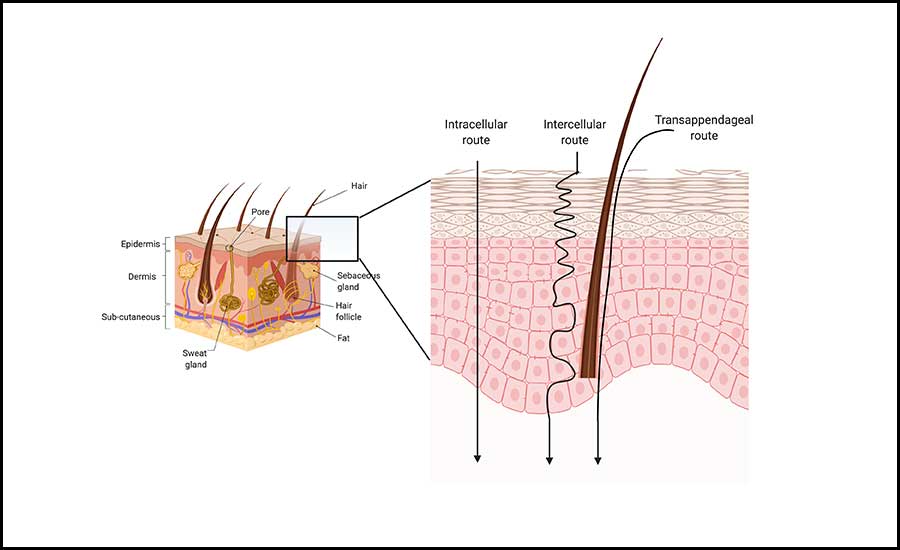Since COVID-19, HVAC industry professionals now know that protecting occupants from inhaling harmful indoor air particles is an essential part of their jobs. Even before the pandemic, managing inhalation exposures was fairly intuitive, since our noses, sinuses, or upper airways alert us to the presence of aromatic substances, allergens, or asthma triggers.
Another very important route from indoor air to our tissues and organs is diffusion through our skin. This transdermal penetration usually goes unnoticed by our five senses, yet the compounds that reach our tissues in this way can reach high concentrations and cause serious illnesses. Pharmaceutical companies value diffusion through skin as a painless yet effective medication delivery route. This is great as long as the medication is delivered in a thoughtful and controlled way. Unfortunately, unintentional exposure to pollutants in the indoor environment are neither healthy nor released in controlled “doses.”
There is value in understanding the similarities and differences between inhalation versus transdermal exposure so that the less emphasized transdermal pathway can be included in exposure assessments and, most importantly, be controlled by HVAC professionals. This column will not address the health impact of ingested (eaten) or radioactive compounds, such as radon.
Inhalation
Inhaled compounds are usually either polar, water-soluble gases that dissolve in our airway mucus or particles of varying sizes that are trapped in passages with diminishing diameters as air travels to our lungs. We are often aware of this because irritation triggers fluid secretions (runny nose), a cough reflex, or wheezing if the muscles in our small airways contract.

FIGURE 1: The average-sized adult has approximately two square meters of skin comprised of three layers: the outermost epidermal layer, middle dermal layer, and innermost subcutaneous layer. Photo courtesy of Building4Health
Transdermal
In contrast, compounds gaining entrance to our deep tissues through the skin are generally nonpolar, fat-soluble molecules that quietly diffuse through cell membranes. A second transdermal route is through microscopic cracks found along hair follicles or in dry or damaged skin. If the chemicals or particles trigger an allergic reaction or result in immediate cell damage because of high concentrations, clear signs such as itching or blistering will occur. When concentrations are lower, however, the intrusion will be undetected yet can cause severe health problems.
Surprisingly, some chemicals and tiny particles absorbed through the dermal route can reach higher levels in our tissues than those achieved through inhalation. Understanding the anatomy of skin and the pollutants that pass through it is key to protecting building occupants.
The average-sized adult has approximately two square meters of skin comprised of three layers: the outermost epidermal layer, middle dermal layer, and innermost subcutaneous layer (see Figure 1). Each layer has a different composition and unique resistance to chemical, thermal, and lightwave stressors in the external environment. Under the skin layers is a network of small vessels that circulate blood for nourishment and contribute to body temperature regulation.
Depending on the pollutant’s molecular weight and characteristics, one of three possible routes can be taken from the ambient air into the blood circulation of an occupant. These are: 1) intracellular route through cell walls; 2) transappendageal route along hair follicles and existing sweat ducts; and 3) intercellular route through cell-cell junctions.
Management of indoor air to reduce the penetration of harmful substances requires not only source control but maintenance of conditions that support healthy skin layers. Source containment includes choosing building materials with low volatile organic compound (VOC) off-gassing, minimizing particle concentrations with humidification and filtration, and supplying adequate ventilation or adsorptive surfaces to remove harmful indoor chemical emissions. Relative humidity (RH) levels in excess of 75% have been associated with increased release of VOCs from materials, so maintaining RH in the healthy 40%-60% range is important.
Environmental conditions that maximize skin health are adequate air-hydration (RH 40%-60%) to prevent dryness and accompanying dermal microcrack formation, use of glazing that prevents overexposure to outdoor ultraviolet light waves, and reduction of indoor oxidants.
In addition to invisible, poor health consequences of dermal penetration, HVAC professionals may be happy to learn that good IAQ will also reduce visible signs of aging. Dermatologists are well aware of the increased wrinkling and uneven skin pigmentation that results from dry skin and ambient chemical exposures. Welcome to a world where engineers’ job descriptions now include cosmetology.



